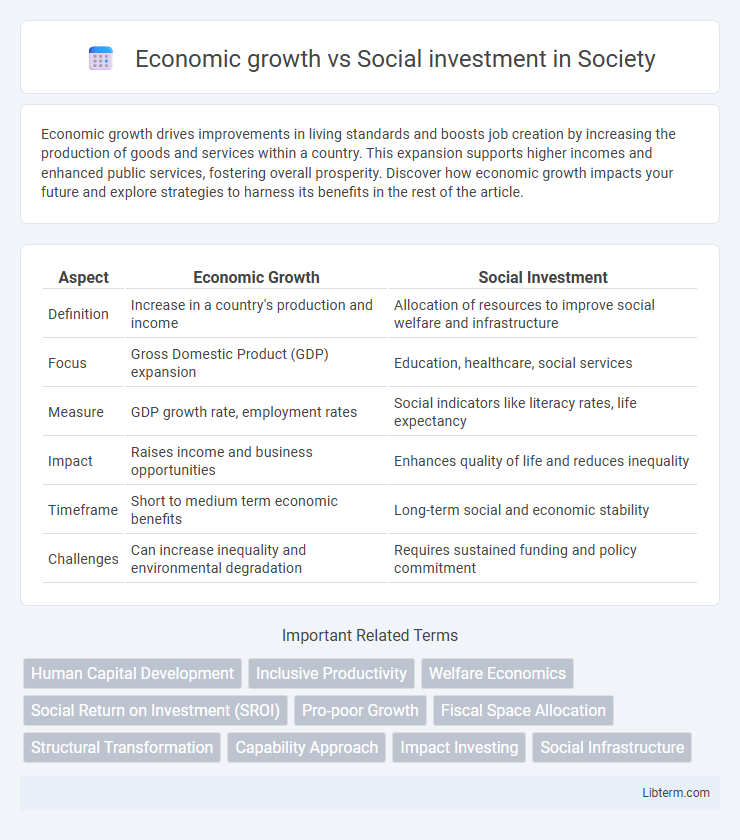Economic growth drives improvements in living standards and boosts job creation by increasing the production of goods and services within a country. This expansion supports higher incomes and enhanced public services, fostering overall prosperity. Discover how economic growth impacts your future and explore strategies to harness its benefits in the rest of the article.
Table of Comparison
| Aspect | Economic Growth | Social Investment |
|---|---|---|
| Definition | Increase in a country's production and income | Allocation of resources to improve social welfare and infrastructure |
| Focus | Gross Domestic Product (GDP) expansion | Education, healthcare, social services |
| Measure | GDP growth rate, employment rates | Social indicators like literacy rates, life expectancy |
| Impact | Raises income and business opportunities | Enhances quality of life and reduces inequality |
| Timeframe | Short to medium term economic benefits | Long-term social and economic stability |
| Challenges | Can increase inequality and environmental degradation | Requires sustained funding and policy commitment |
Understanding Economic Growth: Definitions and Drivers
Economic growth measures the increase in a country's output of goods and services, typically quantified by gross domestic product (GDP). Key drivers include technological innovation, capital accumulation, labor force expansion, and productivity improvements. Understanding these factors helps balance economic growth with social investment to ensure sustainable development and improved quality of life.
The Role of Social Investment in Modern Economies
Social investment significantly enhances modern economies by fostering human capital development, improving education, healthcare, and social protection systems. This approach supports sustainable economic growth through increased productivity, reduced inequality, and stronger social cohesion. Empirical studies indicate countries with higher social investment ratios experience more resilient economic performance and inclusive prosperity.
Economic Growth vs Social Investment: Key Differences
Economic growth primarily measures the increase in a country's output and income, reflected in GDP figures, while social investment focuses on funding education, healthcare, and social services to improve quality of life and human capital. Economic growth drives wealth creation and infrastructure development, whereas social investment targets long-term social stability and equitable distribution of resources. Balancing economic growth with social investment is essential for sustainable development and reducing socioeconomic disparities.
Balancing GDP Growth with Social Outcomes
Balancing GDP growth with social investment ensures sustainable economic development while enhancing quality of life and reducing inequality. Prioritizing healthcare, education, and social protection alongside infrastructure and industrial expansion creates a resilient economy with inclusive benefits. Empirical evidence from OECD countries shows that moderate social spending correlates with higher long-term GDP growth and social stability.
Long-Term Benefits of Social Investment
Social investment yields substantial long-term economic growth by improving human capital, healthcare, and education systems, which increase productivity and innovation over time. Studies show nations allocating higher percentages of GDP to social programs experience lower poverty rates, higher employment, and sustained increases in GDP per capita. Prioritizing social investment enhances economic resilience and reduces future costs related to social inequality and health disparities.
Economic Growth: Short-Term Gains and Pitfalls
Economic growth often delivers rapid GDP increases and boosts employment rates, attracting immediate investor confidence and fostering consumer spending. However, prioritizing short-term economic expansion can lead to resource depletion, income inequality, and environmental degradation, undermining sustainable development. Policymakers must balance immediate growth benefits with long-term social investment to ensure resilient economic stability.
Social Investment’s Impact on Inequality Reduction
Social investment plays a critical role in reducing inequality by funding education, healthcare, and social protection programs that enhance human capital and provide equal opportunities. Evidence shows countries with robust social investment frameworks experience lower income disparities and higher social mobility. Prioritizing social investment supports inclusive economic growth, ensuring wealth distribution benefits broader segments of the population.
Policy Approaches: Prioritizing Growth or Social Welfare?
Policy approaches that prioritize economic growth often emphasize deregulation, tax incentives, and infrastructure development to stimulate business activities and increase GDP. Conversely, strategies focused on social welfare allocate resources to healthcare, education, and social safety nets to enhance overall quality of life and reduce inequality. Balancing these priorities requires integrating growth-driven initiatives with targeted social investments to achieve sustainable and inclusive development.
Global Case Studies: Successes and Lessons Learned
Countries such as China and South Korea demonstrate that balancing economic growth with social investment promotes sustainable development and reduces inequality. Scandinavian nations like Sweden and Norway showcase how robust social welfare systems support high living standards alongside strong GDP growth. Lessons from Brazil highlight the risks of prioritizing rapid economic expansion without adequate social policies, resulting in persistent poverty and social disparities.
Building Sustainable Economies: Integrating Growth and Social Investment
Economic growth and social investment are essential components of building sustainable economies that ensure long-term prosperity and social well-being. Integrating social investment--such as education, healthcare, and social protection--into economic strategies enhances human capital and reduces inequality, which leads to more resilient and inclusive growth. Prioritizing balanced policies that foster innovation and equitable resource distribution strengthens economic stability and supports sustainable development goals.
Economic growth Infographic

 libterm.com
libterm.com